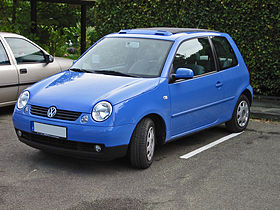Volkswagen Lupo
| Volkswagen Lupo | |
|---|---|
 |
|
| Overview | |
| Manufacturer | Volkswagen |
| Also called | SEAT Arosa |
| Production | 1998–2005 |
| Assembly |
Wolfsburg, Germany Brussels, Belgium |
| Body and chassis | |
| Class | City car (A) |
| Body style | 3-door hatchback |
| Layout | Front-engine, front-wheel-drive |
| Platform | Volkswagen Group A00 platform |
| Related | SEAT Arosa |
| Powertrain | |
| Engine | 1.0 L I4 (petrol) 1.4 L I4 (petrol) 1.6 L I4 (petrol) 1.2 L I3 (diesel) 1.4 L I3 (diesel) 1.7 L I4 (diesel) |
| Transmission | 5-speed manual 6-speed manual 5-speed semi-automatic 4-speed automatic |
| Dimensions | |
| Wheelbase | 2,318 mm (91.3 in) |
| Length | 3,524 mm (138.7 in) |
| Width | 1,640 mm (64.6 in) |
| Height | 1,457 mm (57.4 in) |
| Curb weight | 975 kg (2,150 lb) |
| Chronology | |
| Successor | Volkswagen Fox |
The Volkswagen Lupo is a city car produced by the German car manufacturer Volkswagen from 1998 to 2005.
The Lupo was introduced in 1998 to fill a gap at the bottom of the Volkswagen model range caused by the increasing size and weight of the Polo. The 1998 Lupo was a badge-engineered version of the stablemate 1997 SEAT Arosa. Both use the A00 platform which is a shortened version of the Polo/Ibiza A0 platform. Initially only available in two trim variants, the budget E trim and the upgraded S trim; the range later expanded to include a Sport and GTI variant. Petrol engines ranged from 1.0 to 1.4 (1.6 for the GTI) with diesels from 1.2 to 1.7. The differences between the E and S trim included painted door mirrors, door handles and strip, central locking, electric windows, double folding seats and opening rear windows.
Production of the Lupo was discontinued in 2005, and was replaced by the Fox.
The Lupo name is Latin, meaning wolf, and is named after its home town of Wolfsburg.
The Lupo 3L was a special-edition made with the intent of being the world's first car in series production consuming as little as 3 litres of fuel per 100 kilometres (78 miles per US gallon or 94 miles per Imperial gallon). To achieve this the 3L was significantly changed from the standard Lupo to include:
The 3L, along with the GTI and FSI, had a completely different steel body to other Lupos, using thinner but stronger steel sheet. The car had an automated electro-hydraulic manual transmission with a Tiptronic mode on the selector and an automated electro-hydraulic clutch. The car also had an ECO mode. When engaged it limited the power to 41 bhp (31 kW; 42 PS) (excluding kick down) and programmed the transmission to change up at the most economical point. ECO mode also activated the start/stop function, a feature that was new to European cars at the time. To restart, the driver simply takes his foot off the brake and presses the accelerator. In ECO mode, the clutch was disengaged when the accelerator pedal was released for maximum economy, so the car freewheels as much as possible, with the clutch re-engaging as soon as the accelerator pedal or brake pedal is touched. The 3L also has only 4 wheel bolts and alloy brake drums at the rear, along with many aluminum suspension components.
...
Wikipedia
